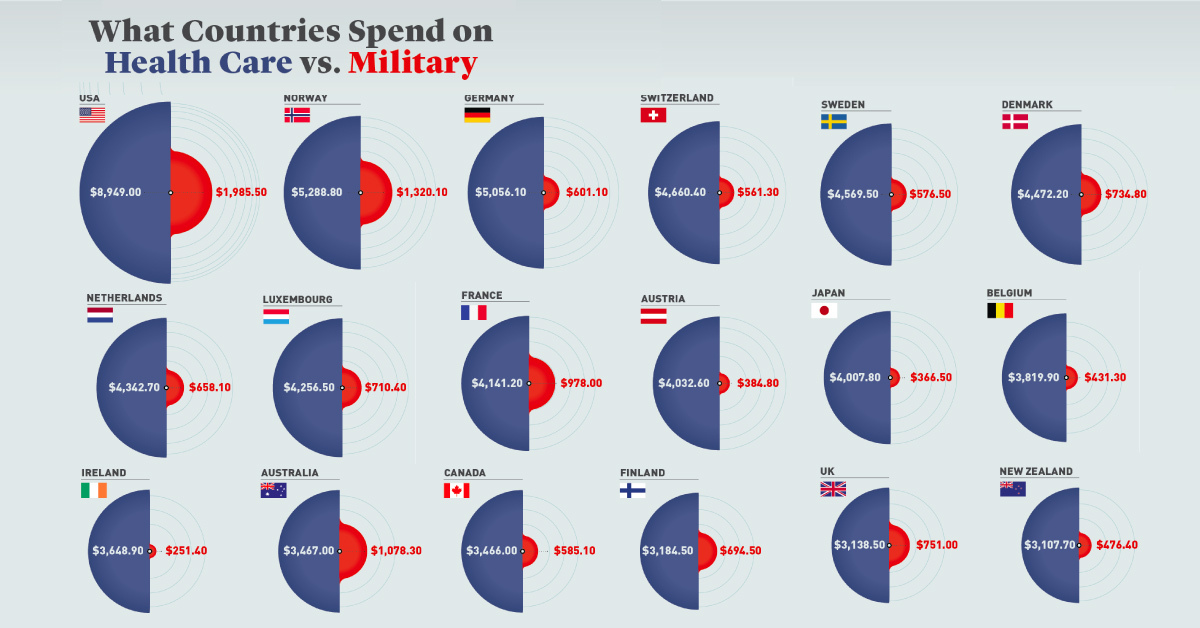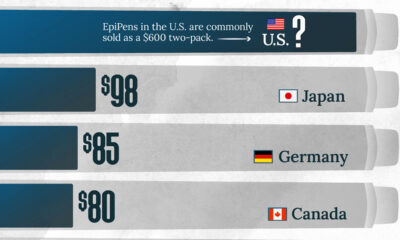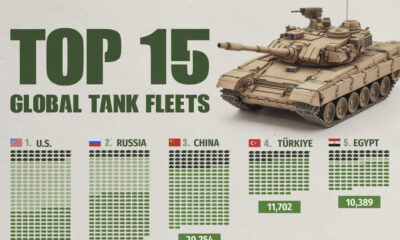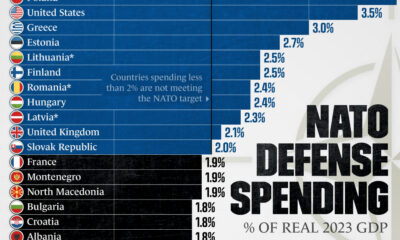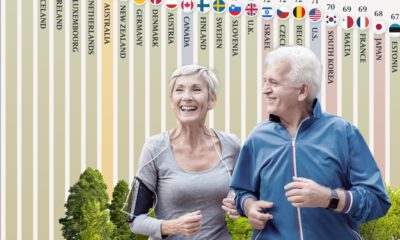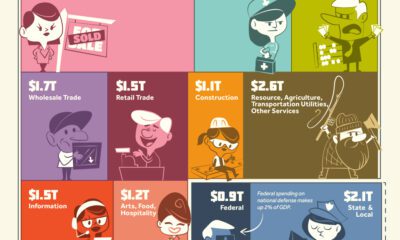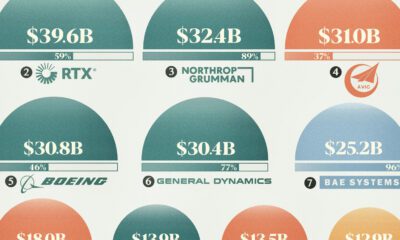Politics
How Much Do Countries Spend on Healthcare Compared to the Military?
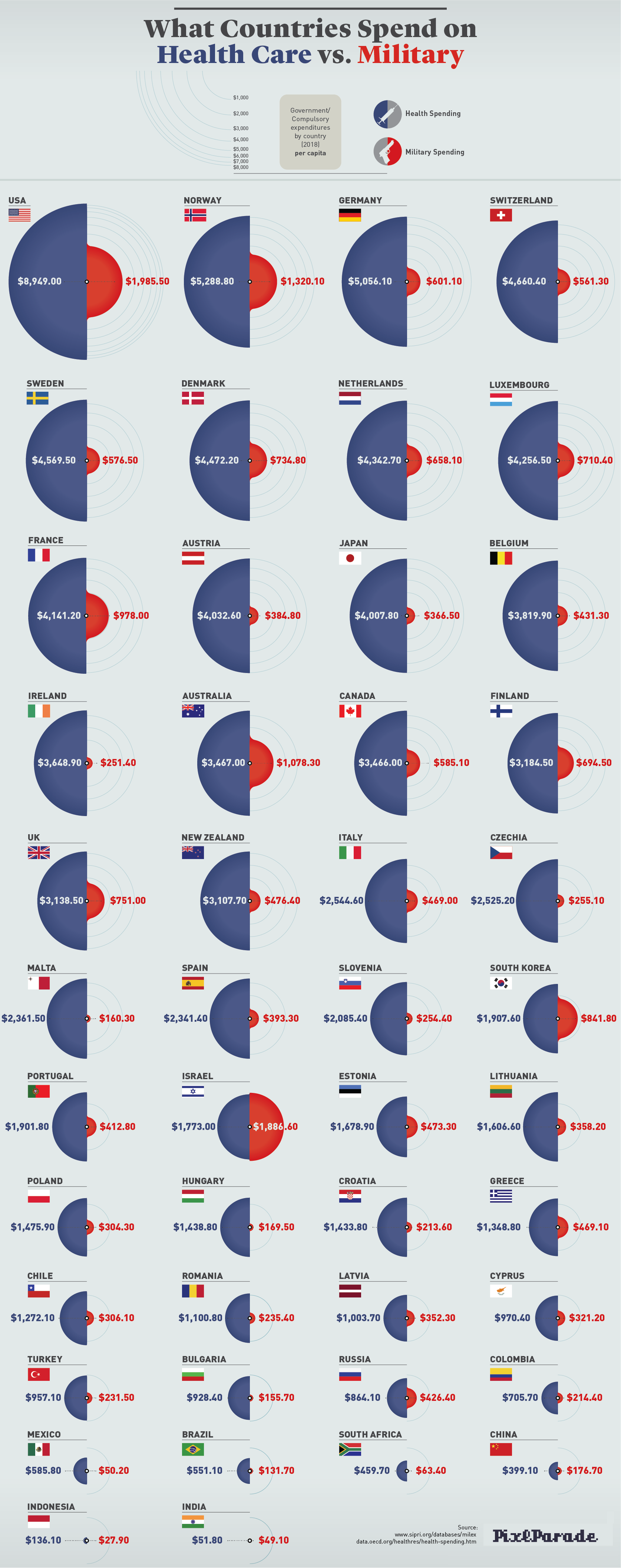
Healthcare vs. Military Spending, by Country
Keeping citizens both healthy and secure are key priorities for many national governments around the world—but ultimately, decisions must be made on how tax dollars are spent to accomplish these objectives, and funding must fall into one bucket or another.
This infographic from PixlParade examines how much 46 different countries put towards healthcare and military spending in 2018, per capita.
Head to Head: Healthcare versus Military
Data for government and compulsory healthcare spending comes from the Organization for Economic Co-operation and Development (OECD). Note that these figures do not include spending through private insurance or out-of-pocket expenses.
Meanwhile, the data for military spending comes from the Stockholm International Peace Research Institute (SIPRI).
| Country | Health spending (Per capita, 2018 US$) | Military spending (Per capita, 2018 US$) |
|---|---|---|
| U.S. | $9,008.77 | $2,086.50 |
| Norway | $5,361.00 | $1,323.90 |
| Germany | $5,262.83 | $559.50 |
| Switzerland | $4,687.26 | $546.00 |
| Sweden | $4,623.68 | $574.90 |
| Netherlands | $4,461.30 | $651.50 |
| Denmark | $4,441.07 | $792.50 |
| Luxembourg | $4,385.66 | $650.80 |
| France | $4,310.55 | $791.00 |
| Austria | $4,137.25 | $381.00 |
| Belgium | $3,868.82 | $421.60 |
| Japan | $3,787.74 | $366.50 |
| Canada | $3,719.86 | $613.10 |
| Ireland | $3,629.43 | $229.80 |
| UK | $3,336.55 | $743.10 |
| Finland | $3,331.65 | $680.30 |
| Australia | $3,311.33 | $1,078.00 |
| NZ | $3,188.39 | $532.30 |
| Czhechia | $2,632.67 | $254.10 |
| Italy | $2,574.96 | $458.70 |
| Malta | $2,448.73 | $152.20 |
| Spain | $2,414.69 | $381.70 |
| Slovenia | $2,227.77 | $254.80 |
| Portugal | $1,906.23 | $431.00 |
| South Korea | $1,848.76 | $841.70 |
| Israel | $1,828.40 | $2,357.50 |
| Estonia | $1,744.57 | $458.60 |
| Lithuania | $1,599.15 | $377.10 |
| Croatia | $1,553.67 | $232.50 |
| Poland | $1,511.18 | $317.50 |
| Hungary | $1,493.01 | $184.60 |
| Romania | $1,344.34 | $223.50 |
| Greece | $1,331.19 | $547.10 |
| Chile | $1,282.59 | $296.10 |
| Latvia | $1,111.67 | $375.20 |
| Cyprus | $1,103.03 | $374.30 |
| Bulgaria | $1,042.85 | $136.30 |
| Turkey | $946.83 | $238.60 |
| Russia | $873.00 | $421.20 |
| Colombia | $864.16 | $204.10 |
| Mexico | $582.05 | $46.30 |
| Brazil | $388.98 | $134.50 |
| South Africa | $267.85 | $63.50 |
| China | $249.83 | $177.60 |
| Indonesia | $55.62 | $28.20 |
| India | $18.80 | $49.00 |
| Source: OECD | Source: SIPRI |
Note: There are minor discrepancies in comparing table data to original sources due to recent estimate updates. Figures for Brazil, South Africa, China, Indonesia, and India come from the World Bank (2017).
The Top 10 Healthcare Spenders
The U.S. leads the world in government healthcare spending at $9,008 per capita – over 1.5 times that of Norway, the next-highest country examined.
| Country | Per capita health spending | % of GDP | % of health spending |
|---|---|---|---|
| U.S. | $9,008.77 | 14.3% | 84.7% |
| Norway | $5,361.00 | 8.6% | 85.3% |
| Germany | $5,262.83 | 9.7% | 84.6% |
| Switzerland | $4,687.26 | 7.6% | 64.4% |
| Sweden | $4,623.68 | 9.3% | 85.1% |
| Netherlands | $4,461.30 | 8.2% | 82.1% |
| Denmark | $4,441.07 | 8.5% | 83.9% |
| Luxembourg | $4,385.66 | 4.4% | 84.1% |
| France | $4,310.55 | 9.4% | 83.6% |
| Austria | $4,137.25 | 7.7% | 74.7% |
While per-capita government spending on healthcare in the U.S. is the highest in the world, this has not necessarily brought about better outcomes (such as longer life expectancy) compared to other developed nations.
It’s also worth mentioning that the above figures do not cover all healthcare costs incurred by citizens, as they do not account for private insurance spending or out-of-pocket expenses. According to OECD data, these additional costs tend to be the highest in places like Switzerland and the United States.
The Top 10 Military Spenders
Israel has the highest rate of military spending per capita, and has the distinction of being the only country on this list to invest more in defense than in healthcare.
| Country | Per capita military spending | % of GDP | Total expenditure, US$M |
|---|---|---|---|
| Israel | $2,357.50 | 5.3% | $19,759M |
| U.S. | $2,086.50 | 3.3% | $682,491M |
| Norway | $1,323.90 | 1.6% | $7,067M |
| Australia | $1,078.00 | 1.9% | $26,840M |
| South Korea | $841.70 | 2.5% | $43,070M |
| Denmark | $792.50 | 1.3% | $4,559M |
| France | $791.00 | 1.3% | $51,410M |
| UK | $743.10 | 1.8% | $49,892M |
| Finland | $680.30 | 1.4% | $3,757M |
| Netherlands | $651.50 | 1.2% | $11,115M |
Although the United States comes in second place here as well, in absolute terms, the U.S. puts more money into military expenditures than many other countries combined, at almost $700 billion per year.
Economy
The Bloc Effect: International Trade with Geopolitical Allies on the Rise
Rising geopolitical tensions are shaping the future of international trade, but what is the effect on trading among G7 and BRICS countries?

The Bloc Effect: International Trade with Allies on the Rise
International trade has become increasingly fragmented over the last five years as countries have shifted to trading more with their geopolitical allies.
This graphic from The Hinrich Foundation, the first in a three-part series covering the future of trade, provides visual context to the growing divide in trade in G7 and pre-expansion BRICS countries, which are used as proxies for geopolitical blocs.
Trade Shifts in G7 and BRICS Countries
This analysis uses IMF data to examine differences in shares of exports within and between trading blocs from 2018 to 2023. For example, we looked at the percentage of China’s exports with other BRICS members as well as with G7 members to see how these proportions shifted in percentage points (pp) over time.
Countries traded nearly $270 billion more with allies in 2023 compared to 2018. This shift came at the expense of trade with rival blocs, which saw a decline of $314 billion.
Country Change in Exports Within Bloc (pp) Change in Exports With Other Bloc (pp)
🇮🇳 India 0.0 3.9
🇷🇺 Russia 0.7 -3.8
🇮🇹 Italy 0.8 -0.7
🇨🇦 Canada 0.9 -0.7
🇫🇷 France 1.0 -1.1
🇪🇺 EU 1.1 -1.5
🇩🇪 Germany 1.4 -2.1
🇿🇦 South Africa 1.5 1.5
🇺🇸 U.S. 1.6 -0.4
🇯🇵 Japan 2.0 -1.7
🇨🇳 China 2.1 -5.2
🇧🇷 Brazil 3.7 -3.3
🇬🇧 UK 10.2 0.5
All shifts reported are in percentage points. For example, the EU saw its share of exports to G7 countries rise from 74.3% in 2018 to 75.4% in 2023, which equates to a 1.1 percentage point increase.
The UK saw the largest uptick in trading with other countries within the G7 (+10.2 percentage points), namely the EU, as the post-Brexit trade slump to the region recovered.
Meanwhile, the U.S.-China trade dispute caused China’s share of exports to the G7 to fall by 5.2 percentage points from 2018 to 2023, the largest decline in our sample set. In fact, partly as a result of the conflict, the U.S. has by far the highest number of harmful tariffs in place.
The Russia-Ukraine War and ensuing sanctions by the West contributed to Russia’s share of exports to the G7 falling by 3.8 percentage points over the same timeframe.
India, South Africa, and the UK bucked the trend and continued to witness advances in exports with the opposing bloc.
Average Trade Shifts of G7 and BRICS Blocs
Though results varied significantly on a country-by-country basis, the broader trend towards favoring geopolitical allies in international trade is clear.
Bloc Change in Exports Within Bloc (pp) Change in Exports With Other Bloc (pp)
Average 2.1 -1.1
BRICS 1.6 -1.4
G7 incl. EU 2.4 -1.0
Overall, BRICS countries saw a larger shift away from exports with the other bloc, while for G7 countries the shift within their own bloc was more pronounced. This implies that though BRICS countries are trading less with the G7, they are relying more on trade partners outside their bloc to make up for the lost G7 share.
A Global Shift in International Trade and Geopolitical Proximity
The movement towards strengthening trade relations based on geopolitical proximity is a global trend.
The United Nations categorizes countries along a scale of geopolitical proximity based on UN voting records.
According to the organization’s analysis, international trade between geopolitically close countries rose from the first quarter of 2022 (when Russia first invaded Ukraine) to the third quarter of 2023 by over 6%. Conversely, trade with geopolitically distant countries declined.
The second piece in this series will explore China’s gradual move away from using the U.S. dollar in trade settlements.

Visit the Hinrich Foundation to learn more about the future of geopolitical trade

-

 Economy2 days ago
Economy2 days agoEconomic Growth Forecasts for G7 and BRICS Countries in 2024
The IMF has released its economic growth forecasts for 2024. How do the G7 and BRICS countries compare?
-

 United States2 weeks ago
United States2 weeks agoRanked: The Largest U.S. Corporations by Number of Employees
We visualized the top U.S. companies by employees, revealing the massive scale of retailers like Walmart, Target, and Home Depot.
-

 Economy2 weeks ago
Economy2 weeks agoWhere U.S. Inflation Hit the Hardest in March 2024
We visualized product categories that saw the highest % increase in price due to U.S. inflation as of March 2024.
-

 Economy1 month ago
Economy1 month agoG20 Inflation Rates: Feb 2024 vs COVID Peak
We visualize inflation rates across G20 countries as of Feb 2024, in the context of their COVID-19 pandemic peak.
-

 Economy1 month ago
Economy1 month agoMapped: Unemployment Claims by State
This visual heatmap of unemployment claims by state highlights New York, California, and Alaska leading the country by a wide margin.
-

 Economy2 months ago
Economy2 months agoConfidence in the Global Economy, by Country
Will the global economy be stronger in 2024 than in 2023?
-

 Debt1 week ago
Debt1 week agoHow Debt-to-GDP Ratios Have Changed Since 2000
-

 Markets2 weeks ago
Markets2 weeks agoRanked: The World’s Top Flight Routes, by Revenue
-

 Demographics2 weeks ago
Demographics2 weeks agoPopulation Projections: The World’s 6 Largest Countries in 2075
-

 Markets2 weeks ago
Markets2 weeks agoThe Top 10 States by Real GDP Growth in 2023
-

 Demographics2 weeks ago
Demographics2 weeks agoThe Smallest Gender Wage Gaps in OECD Countries
-

 Economy2 weeks ago
Economy2 weeks agoWhere U.S. Inflation Hit the Hardest in March 2024
-

 Green2 weeks ago
Green2 weeks agoTop Countries By Forest Growth Since 2001
-

 United States2 weeks ago
United States2 weeks agoRanked: The Largest U.S. Corporations by Number of Employees

